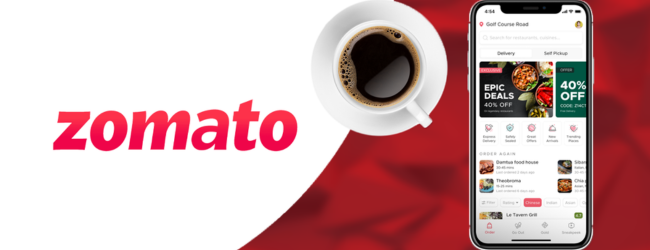Table of contents
Zomato is one of India’s top food delivery and restaurant discovery platforms. Founded in 2008, it has transformed the way people order food and explore dining options. But how exactly does Zomato work and earn money? In this article, we will decode the Zomato business model in a simple and structured way, covering its revenue streams, operations, and future growth strategies.
What is Zomato?

Zomato is a food-tech company that connects users with restaurants through its app and website. It operates in several countries, but India remains its core market. Here are some basic facts:
- Founded: 2008 by Deepinder Goyal and Pankaj Chaddah
- Headquarters: Gurugram, India
- Services Offered: Food delivery, restaurant listings, table bookings, B2B services for restaurants
- Monthly Active Users: 70+ million (2024)
Zomato Business Model: Core Pillars
Zomato follows an aggregator-based business model that brings restaurants and customers together on a digital platform. Let’s break this down:
1. Customer Side (B2C Model)
- Users can browse restaurant menus, place food orders, rate/review food, and book tables.
- Zomato uses AI-driven recommendations for better personalisation.
2. Restaurant Partner Side (B2B Model)
- Restaurants pay for increased visibility, advertising, and logistical support.
- Zomato provides data analytics, customer feedback, and order management tools.
3. Delivery Fleet (Logistics Model)
- Zomato uses gig workers (delivery partners) to complete deliveries.
- It optimises routes using AI and GPS tracking.
Zomato Revenue Streams
Zomato has built multiple income sources to ensure stability. Here’s a breakdown:
| Revenue Stream | Description |
|---|---|
| Food Delivery | Commissions from partner restaurants (15-25% per order) |
| Zomato Gold / Pro Plus | Paid subscription for free delivery & discounts |
| Advertising | Restaurants pay for top listing, banner ads, and sponsored content |
| Hyperpure | Supplies raw materials to restaurants (B2B) |
| Zomato Live Events | Curates food festivals, cooking classes, etc. |
| Cloud Kitchens | Runs or partners with delivery-only kitchens |
| Intercity Legends | Premium service to deliver iconic dishes from top Indian cities |
Note: In FY 2024, Zomato earned over INR 9,500 crore (~$1.15 billion) in revenue.
💡 Pro Tip: If you want to start a Business but have too many doubts, connect with a Business expert from Boss Wallah for guidance – Check Out
How Zomato Operates: Key Components
1. Technology Infrastructure
- Mobile App & Website: User-friendly, fast, multilingual.
- AI Algorithms: Personalise recommendations and optimise delivery routes.
- Payment Gateway: Integrates with UPI, wallets, cards, and COD.
2. Logistics & Delivery Management
- 3L+ active delivery partners
- Real-time order tracking
- Route optimisation to reduce delivery time and fuel cost
3. Customer Support & Feedback
- 24/7 live chat support
- AI-powered issue resolution
- Public and private review systems
4. Restaurant Partner Services
- Hyperpure for kitchen needs
- Data dashboard to analyse orders, ratings, and reviews
- Zomato Restaurant Management App (ZRMA)
ALSO READ | Story of Zomato Founder and His Entrepreneur Wife: Separate Ventures, Shared Ambition
Zomato’s Growth Strategy & Future Vision
1. Focus on Profitability Over Growth
Zomato aims to reduce its burn rate by focusing on unit economics and reducing free deliveries.
2. Expand Hyperpure
- Goal: Become India’s largest food-supply chain
- Offering vegetables, grains, meats, and packaging to restaurants
3. Deepen Penetration in Tier-2 & Tier-3 Cities
- Partnering with local restaurants
- Hiring regional delivery staff
4. Innovate with AI & Machine Learning
- Predictive analytics for demand forecasting
- AI chatbots for customer service
5. Intercity Food Delivery Expansion
- Delivery of iconic dishes across states
- Ensures packaging, freshness & brand authenticity
6. Sustainability Goals
- EV-based delivery vehicles
- Minimal plastic packaging
Highlight: Zomato is actively working towards a carbon-neutral delivery ecosystem by 2030.
ALSO READ | Who Founded Zepto? Zepto Founder Age, Net Worth & More
Pros & Cons of Zomato Business Model

Pros
- Diversified revenue streams
- Strong brand recall and loyal user base
- Scalable model
- Backed by technology and data insights
Cons
- Heavy competition (Swiggy, Amazon Foods, ONDC)
- Low profit margins
- High dependency on delivery staff and weather
Need Expert Guidance?
Starting a business can be challenging, but you don’t have to do it alone! At Boss Wallah, our 2,000+ business experts are ready to provide valuable insights and guidance. Whether you need help with marketing, finance, sourcing, or any other area of any business, our business experts are here to help you succeed
Confused about Which Business to Start?
Want to start your own business but unsure which one to choose? Explore Boss Wallah, where you’ll find 500+ courses by successful business owners, featuring practical, step-by-step guides on starting and growing various businesses.
Find your perfect business idea today
Conclusion
The Zomato business model is a mix of technology, logistics, B2B, and customer experience. With smart diversification into Hyperpure, cloud kitchens, and intercity food delivery, Zomato is preparing itself for a more profitable and sustainable future. As long as it continues to innovate and adapt, it will remain a dominant player in the Indian food tech industry.
Frequently Asked Questions (FAQs)
1. How does Zomato make money?
Through food delivery commissions, subscriptions, restaurant advertising, and B2B services like Hyperpure.
2. What is Hyperpure in Zomato?
It’s Zomato’s B2B platform that supplies fresh ingredients to restaurants.
3. What is Zomato Gold/Pro Plus?
A paid membership offering benefits like free deliveries, discounts, and early access to deals.
4. How much commission does Zomato charge restaurants?
Typically between 15% to 25% per order.
5. Is Zomato profitable?
As of FY 2024, Zomato has moved towards breakeven and shows a positive EBITDA margin.
6. What are Zomato’s future plans?
Focus on profitability, expand Hyperpure, deepen rural reach, and scale AI-driven innovation.
7. Who are Zomato’s main competitors?
Swiggy, ONDC (Open Network for Digital Commerce), and Amazon Foods.
8. Does Zomato own restaurants?
No, but it partners with cloud kitchens and delivery-only brands.
9. What is Zomato Intercity Legends?
A service that lets users order iconic dishes from other cities across India.
10. How many orders does Zomato process daily?
Over 2 million food orders every day across India.


